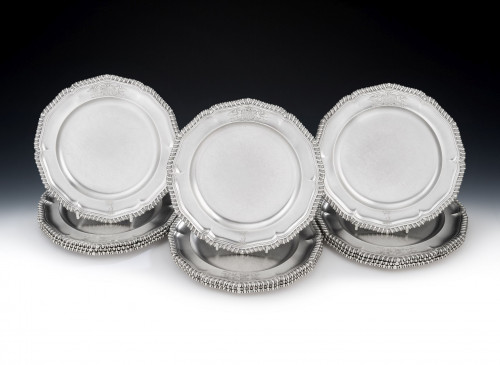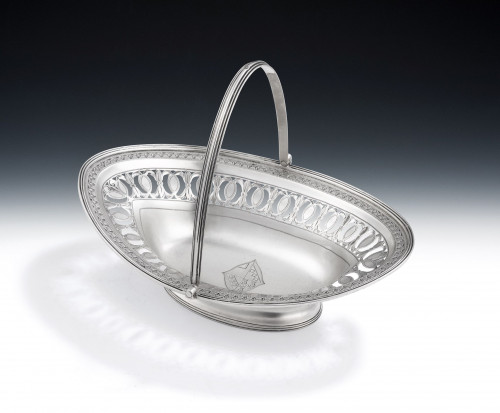- Home
- British Silver 1760-1830
- The Lissadell House Candelabra. An important pair of George III cast Silver Gilt Candelabra made in London in 1805 by Edward Capper.
The Lissadell House Candelabra. An important pair of George III cast Silver Gilt Candelabra made in London in 1805 by Edward Capper.
The Lissadell House Candelabra. An important pair of George III cast Silver Gilt Candelabra made in London in 1805 by Edward Capper.
375203
The Figurative Candelabra are cast and stand on stepped circular bases decorated with both acanthus leaves and spears which rise to a stepped platform. The design of the figurative section is taken from ancient Greece and depict two draped female figures of nobility finely detailed in their casting with material folds and their hair being beautifully arranged. Both hold aloft the branches, as if torch bearers. The branches divide in the centre and display beautiful leaf capped scrolls. The centre also rises to a cast pineapple, a symbol of wealth, within a leaf cone. Each branch rises to a foliate platform decorated with six detailed, downturned, leaves. The tulip shaped candle sockets screw into the platform and are also decorated with raying foliate motifs. Each socket also displays a detachable sconce with scalloped edge, also decorated underneath with leaves. Both the base and sconces are all engraved with a contemporary double Crest and each piece is marked in no less than eight different locations, sixteen sets of marks between the pair. As you will appreciate, these make quite some statement on the table, being sculptural works of art. Also, being silver gilt, they were made for the top level of the market.
The influence for this design almost certainly comes from the design books of Pitts and Preedy and a similar pair made for Queen Caroline of Great Britain, Queen Consort of King George IV, were sold in 2023 by Mary Cooke Antiques and are shown in our archive. These were made in London in 1798 by Pitts and Preedy. The work of Edward Capper is scarce, but always of fine quality. His first mark was entered on 8th November, 1792. He had workshops at 3, Georges Court, Clerkenwell when these pieces were made.
The Crest on the left ( on a garland of laurel a lion passant) is of the Booth family and the one on the right is a wolf rampant for the Gore family. They are those of the Gore-Booth family of Lissadell House, County Sligo, Ireland. They are specifically those of Sir Robert Newcomen Gore-Booth, 3rd Baronet. He was born in 1746, son of the 1st Baronet and brother of the 2nd. He married Hannah Irwin in 1804, the same year that his brother died and he succeeded to the Lissadell estates. It is probably that these were commissioned to celebrate his accession or marriage. An image of Lissadell House is shown.
The estate was formed from land granted in the early 17th century to the Elizabethan soldier, Sir Paul Gore for his services to the Crown during the Nine Years War. The estate was huge and consisted of 32,000 acres. It was the childhood home of Irish Revolutionary, Constance Gore Booth who married Count Markievicz and was the first woman elected to Westminster, but refused to swear the oath. It was also the sometime holiday retreat of the World renown poet, William Butler Yeats.
Height: 17 inches.
Length, across the branches, 10 inches.
Base Diameter: 5.5 inches.
Weight: 90oz.
PRICE £ 16,500
Thank you for your enquiry.
We will get back to you soon.
Please create wishlist to add this item to
RELATED ITEMS



























